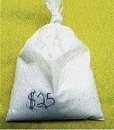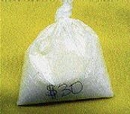

Ian Allen/Staff Photograper
LEFT: Credit cards are often used to make large supermarket purchases.
RIGHT: Shopping in an uptown supermarket gives the housewife wider aisles, a well- organised layout and the opportunity to select the items she needs.
Readers who grew up in any of Jamaica's deep rural districts in the '60s and '70s will be familiar with a method of shopping for groceries and other essentials that still, out of necessity, obtains today.
Back then, shoppers went to the grocery store in the district to make purchases including big gill of cooking oil; an ounce of butter; a pound of flour mixed with a little cornmeal and a quarter-pound of salt fish and other staples. Men who smoked bought one or two cigarettes at a time, and fresh meat, such as beef, pork or chicken, was only available from the butcher once per week.
That was in stark contrast to the more affluent members of the community who sent a list of items to the shopkeeper who wrote them in a book and kept careful records for the end of the month or week when the bill was to be paid.
As times changed and there was an urban drift, supermarkets and wholesale outlets offering bulk-buying alternatives made a lot more sense, particularly for persons earning a monthly wage.
As the pendulum swings back to hard times, some trends have again emerged. Many poor people simply cannot afford the ever-increasing supermarket bills.
Stock up
Uptown shoppers will go to supermarkets or larger centres such as PriceSmart and Mega Mart to stock up on enough paper products, canned goods and toiletries to last for months. This way, they stay ahead of the game, missing price increases and the effects of a rapidly devaluing dollar.
Out in the rural hamlets, villagers live off the land by saving hundreds of dollars annually on vegetables and fruits grown on their farms or in their backyards. Even United States First Lady Michelle Obama has started a home fruit and vegetable garden.
But Outlook recently learnt that inner-city residents are now buying enough ketchup for a meal, soap powder or bleach to wash one dress or shirt, shampoo and conditioner for one use and even enough hair gel for a few days.
For clothes and shoes, all the latest cuts, colours and styles are readily available on sidewalks or at market stalls. And the women certainly look sharp and fashionable at all the dances and stage shows. Meanwhile, their uptown sisters continue to shell out big bucks at trendy boutiques.
barbara.ellington@gleanerjm.com




Photos by Keisha Shakespeare-Blackmore
(1)This little plastic bag of ketchup is enough for one meal and is available from downtown Kingston vendors for $20.
(2) Conditioner that is enough to fo the hair once costs $25.
(3) Can't afford supermarket-brand bleach? Try the powdered variety from vendors in downtown Kingston for a mere $20.
(4) This bag contains shampoo to cleanse the hair once; it costs $30.